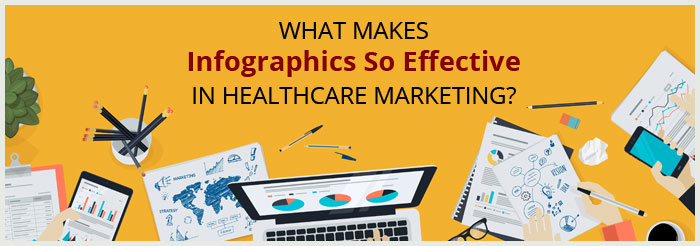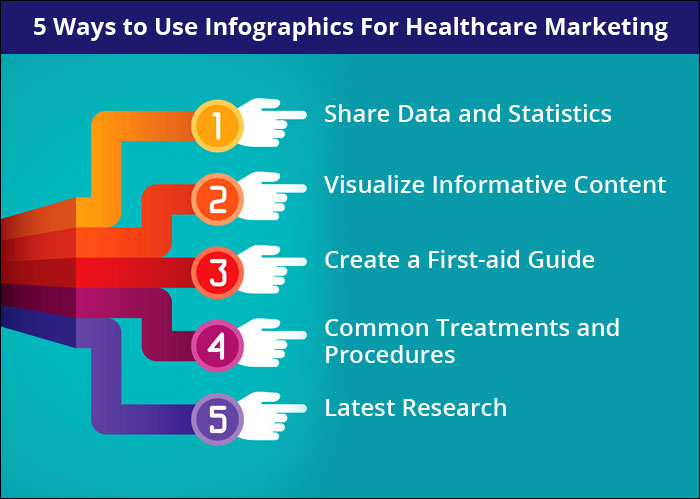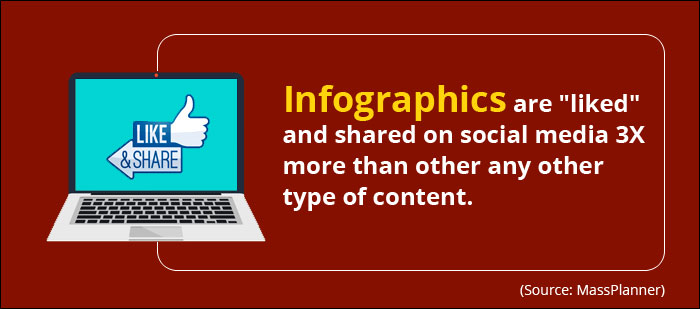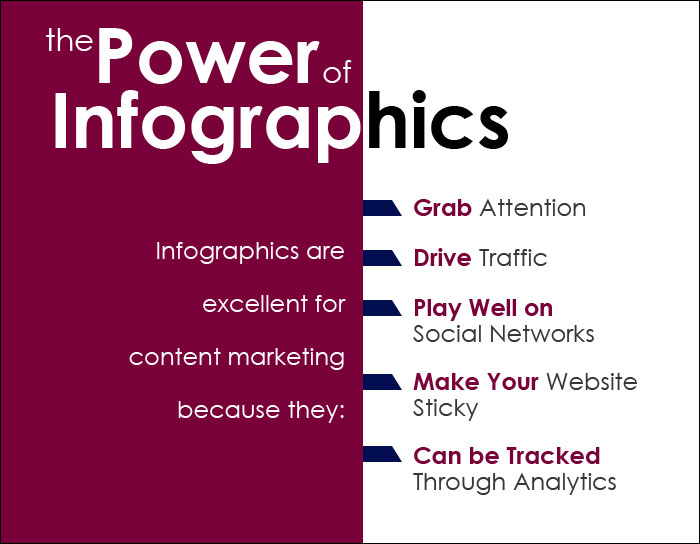What Makes Infographics So Effective in Healthcare Marketing?
Posted on
If you want to widen the reach of your brand message quickly and creatively, infographics are the answer. Infographics are all about stirring the creative storm in your coffee mug. This is because humans love visuals. Our brains like them, and they process them 60,000 times faster than plain text. However, there is more:
Not only do our brains process graphics faster than text, but we also respond to them in ways that make infographics an amazingly effective marketing tool.
Here are a few juicy stats to get you started:
- The human brain remembers 80 percent of what it sees, versus 20 percent of what it reads. So, whatever brand message your infographic is designed to deliver, your target audience will remember a lot more of it than if you simply write it down.
- Nearly 40 percent of people will respond positively to visual information rather than plain text.
- Almost 85 percent of people say color, not words, is the biggest reason they buy a product.
- Digital content marketing approaches, such as infographics, can cost 62 percent less than traditional marketing and can generate three times as many leads.
Impressive and powerful, no?
So, rich infographics produce far more positive reactions than text, which provides a strong argument for using them in branding and marketing activities.
What other reasons make infographics so effective?

1. Improve Brand Awareness: Infographics are designed to include the name of the medical practice that created it, along with its logo and other useful business information. Infographics can convert complex data into lovable breadcrumbs that cannot escape the attention of healthcare marketers looking for innovative ways to engage patients. Nearly 65 percent of digital healthcare marketers use infographics to push their brand message. According to research, infographics get 94 percent more viewership than other static content, making them the most reliable pillar of the healthcare marketing strategy.

Remember that research about humans retaining 80 percent of visual information?
This is where it comes into play. When target audiences see your brand name on an infographic, they tend to absorb the information and remember it for longer, and keep your brand name front of mind.
2. Tell Your Brand Story: Most infographics are like a super-cool collection of data in an exciting form, and they do an excellent job of storytelling. They are perfect for linking multiple content into a single frame. When done right, infographics are more attractive than other forms of content. A creatively designed infographic can produce an effect that makes the human brain light up like a Christmas tree. Do you want to know why? This is because the human brain is wired to relate to stories. It helps us connect with the world around us and invokes all kinds of emotions. It is humanly impossible to read hundreds of blogs and retain even a percent of that. So, if you create a relevant infographic that tells a story about your practice, you are likely to see massive audience engagement.
3. Catch Your Audiences’ Attention: Because humans are visual creatures, they are easily attracted to visually appealing elements. If plain text fails to capture the attention of your target audiences, then visual elements such as infographics can do the trick. When combined with useful and relevant text, infographics can be a powerful tool to help your message cut through the information noise and into your audiences’ brains. Humans love facts, stats and graphic elements, and if compelling enough, the message conveyed through your infographics can capture their attention.
4. Boost SEO Efforts: Infographics that are designed and promoted correctly can take your healthcare marketing strategy a step further. If your infographic talks about a hot topic or explains a disease or treatment option, other relevant websites will find value in linking to your informative content. Link building will strengthen your website’s search engine optimization (SEO). The more related and popular websites link to your content, the more importance search engines will assign to your website. The more links you build, the higher you will be placed on search engine results pages (SERPs), and the better you will perform in organic search results. Website traffic and backlinks are excellent for SEO, and infographics are proven to be amazing drivers of both.

5. Easily Sharable: One of the most compelling features of infographics is their ability to be shared across different platforms. Infographics have the potential to go viral when shared with different communities. An infographic shared on a social network can be compelling enough for a user to share it with other communities outside of social networks. When you create infographics that relate to your target audiences, you will be able to extend your reach further. Infographics connect with your target audiences better than any other type of content on social media. In fact, infographics receive three times more likes and shares than other content types. Whether you want to grow your social presence or attract new patients to your practice, infographics are a smart choice.

How to Market Your Infographics
Infographics are one of the most popular ways to share significant amounts of information in a visually appealing and easy-to-understand format. When designed correctly, infographics are interesting, useful and a visual delight.
One of the practical ways to repurpose content is to design an infographic using the same information. Here are seven ways in which you can improve your infographic ROI and promote your medical practice more efficiently:
1. Identify the Right Influencers: Think about the objective of the infographic and who would benefit from the content. You must look for influencers in this niche and reach out to them with a link to the infographic. Be sure the selected influencers are in alignment with the message of the infographic and the planned marketing goals.
2. Promote on Pinterest: Pinterest is one of the most popular networks for sharing an infographic. This is because Pinterest is a visual search engine designed for social sharing. Before sharing the infographic on Pinterest, make sure the design is perfect, and the pin is clear. To ensure it is found when searchers are looking for the topic, it is important to write the description with SEO aspects in mind. Pinterest is also one of the few online places where the infographic will be visible in its entirety. Make sure your medical practice name, logo and website URL are clearly identified at the top of the infographic to help searchers identify the source.
3. Get Creative on Instagram: Instagram demands a different promotional approach because the format is limited. You can also consider creating a video that shows the entire thing. Instagram is one of the platforms that rely on hashtags to help searchers locate relevant content. Once the graphic is posted with its description, you must use some relevant hashtags in the first comment of the image without cluttering up the description.
4. Share on Facebook: Facebook has a huge variety of requirements depending upon how the graphic will be posted. Have a cheat sheet for image dimensions that will be used for promotional purposes and will make it easier to create an image that can be viewed and shared on Facebook. Usually, people create a thumbnail image of the infographic and link it back to the original image. Alternatively, you can crop the infographic to show only the heading or a specific portion that will entice searchers to see the full image.
5. Link Back on Twitter: Sharing on Twitter is a mix of how to share on Instagram and Facebook. You will want to use hashtags and link back to the original image. If any of the companies that are mentioned in the infographic are on Twitter, tagging them will help attract their followers and may also result in a retweet that will help expand the reach. Even on this platform, a thumbnail or cropped image may be more helpful. However, a well-written description can also work.
6. Use Guest Blogging: This is an excellent way to reach a broader audience in your area. You can start by locating blogs that accept guest posts and gather ideas for an article that supports the infographic to be promoted. The goal is to add value to the blog’s readers. However, you must remember, it is not enough to simply repurpose the information in the infographic. It is essential to create new content that utilizes the infographic as a source.

7. Optimize Landing Page: One of the biggest objectives of promoting an infographic is to generate interest in your brand. To do this efficiently, it is essential to optimize the landing page where the infographic is placed. You must make sure it is mobile-friendly and the graphic is large enough to be noticed as soon as visitors arrive. In addition, the landing must load quickly and be user-friendly with few distractions. It is an essential component in successfully promoting your infographic.
Dos and Don’ts of Infographics
Dos
1. Tell a story. Be sure to include a beginning, middle and an end.
2. Keep your message concise and straightforward.
3. Look for innovative ways of visualizing the data.
4. You must use standard associations, as well. If you can convey your message with an image, then do so.
5. An infographic must always reveal its sources and show accountability and transparency.

Don’ts
1. Do not create infographics just for the sake of it.
2. Don’t push your brand or service through an infographic, as it may not give you the desired engagement levels.
3. Don’t get over-excited with information, even if you have plenty of it. You must only include data that supports your message and is relevant to it.
4. Don’t add design tricks just for the sake of it as it can lead to an intricate design.
5. Don’t tweak, delete or distort data to suit your message.
Tips for Success
If you are ready for an infographic, the best way to is to work with a healthcare marketing agency that understands your mission and vision. A healthcare marketing agency can make sure the content is relevant and the infographics are easily shareable on your social media channels. Here are five tips for making sure you achieve an incredible outcome.
- Have a clear goal in mind. You need to follow a path within the infographic so that readers start from the beginning and get to the end of the infographic.
- Determine the overall look the infographic. Limit the color palette. Do not make the infographic look cluttered or clumsy.
- Avoid all kinds of special effects such as drop shadows and 3D. You must try to use flat vector graphics that help the readers see what is critical.
- Submitting to infographic directories will help to get your infographic out there. Some of the online directories offer benefits such as backlinks and social signals, which are great for SEO.
- When organizing content, thinking visually is important. You must remember not every statistic will make a good visualization, and not every visualization will be suitable for your infographic.

Wrapping Up
Creating an appealing and impactful infographic is a labor of love, which requires extensive research, great copywriting, and an overflow of creative juices. It is obvious to want to see this content shared by others. The effort and time it takes to create successful infographics make people even more excited to share their hard work with the world.
While the prime agenda of an infographic may be to get your practice’s name out there, it is the ideal medium to sell your services or attract more patients to your practice. Infographics are known to be attention-getters. The infographic does not necessarily have to attract more patients to your practice, just make target audiences aware of your existence and, hopefully, drive some of them to your website where you will have informative content to keep them once you have them.

 Why Good communication Matters in Healthcare
Why Good communication Matters in Healthcare De-Escalation Tips for Handling Aggressive Patient..
De-Escalation Tips for Handling Aggressive Patient.. Reaching The Right Audience Through Target Marketi..
Reaching The Right Audience Through Target Marketi..